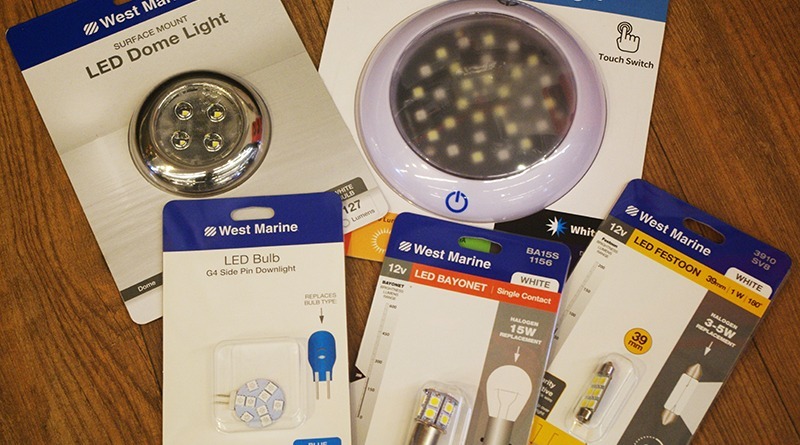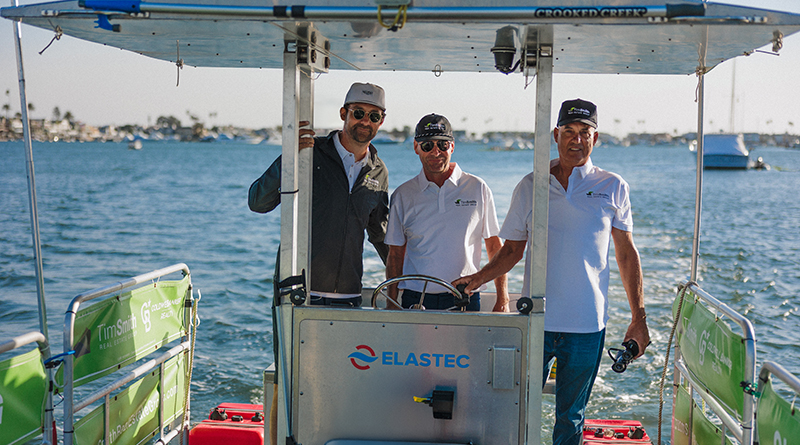Your boat is your castle on the water, and if you are like most boaters, you want both your deck and cabin lighting systems to be bright and, just as importantly, easy on the house battery charge.
Even by using a robust charging system complete with solar panels and a wind turbine, using traditional incandescent light bulbs for long periods at anchor without wind can drain a house battery bank to a point so low that damage to the bank could be irreversible.
Just to review what we learned in middle school science, an incandescent bulb glows by sending current through a fine metallic filament, usually tungsten, sometimes in the shape of a spring but often just a straight wire between two glass posts within a vacuum bulb. Not much has changed in filament material or energy savings in the incandescent light bulb since Thomas Edison developed this little wonder in the late 19th century.
Today, we have some relatively new technology on our side: light-emitting diodes, or LEDs, which use only a small fraction of the power consumed by incandescent bulbs and also less than halogen, but produce far more light than these predecessors.
An LED produces light by sending electricity through a small piece of semiconductor material. Instead of producing heat, electrons jumping across the diode release pure light energy. This is a huge scientific leap in how we use the limited power sources available to us, particularly on a boat completely detached from land-based power sources.
In contrast, both incandescent and halogen bulbs produce far more heat than light. Incredibly, LEDs use 80% less power than halogen bulbs and 75% less than incandescents. Furthermore, an LED will last eight times the lifespan of a halogen bulb and 12 times that of an incandescent bulb.
If you are a boat owner, you might be concerned about having to rewire your vessel’s electrical circuitry, including lighting fixtures. If you walk into the lighting section of your local chandlery, you will see LED bulbs matching the types of fixtures currently installed in your boat’s cabin and on the cabin’s exterior.
Your new replacement LED bulbs will have the same exterior shape and mounting base as your old incandescent and halogen bulbs, so in most cases, you won’t need to worry about rewiring your boat and changing light bulb sockets.
There is a misunderstanding among some boaters claiming LEDs have only two power settings: ON with blinding bright light and OFF. You can rest assured your LEDs will have the same capacity for adjusting from dim to bright just like the old bulbs of your childhood. In the case of some cabin lights, though, many traditional light sockets, including those on my 1966 Cal 30 sloop “Saltaire,” are on-off toggles. They work fine for me, but if you too have an older vessel, consider installing new dimmer switches capable of full rotation from dim to bright in place of your binary switches.
Another critical detail to consider in shopping for LED bulbs is the type of alloy used in the mounting base, be it a screw mount or a two-prong bayonet mount, as is usually the case with bulbs used as navigation lights. Make sure the base is either brass or, even better, zinc-plated brass for a long life in a marine environment.
With marine LEDs, such as those available from Ancor, Imtra and Lunasea, you may pay a bit more than at your local chain hardware store, but you can sail secure with the knowledge you have lights with alloy mounts designed to withstand a moist, salt-laden atmosphere.
If you are looking for a set of LEDs for your vessel’s cabin lights, consider the selections offered by your local marine store, such as Downwind Marine or US Chandlery in San Diego, Captain’s Locker in Long Beach or any of the West Marine outlets in your area. By waiting a few days, of course, you can save a few bucks by ordering a set of festoon or bayonet replacement LED bulbs online from Ledyotry, Linkstyle, Nilight or any of the other many manufacturers and distributors of LED lighting materials.
A total redesign and reinstallation of your boat’s lighting system could also include cluster lights, which are tiny LEDs set on a long string or wide strap and draped around the interior or exterior of the cabin, including rigging. Before you get too creative, though, remember to keep such lighting devices from interfering with your boat’s navigation (“running”) lights, which are required by the U.S. Coast Guard to be uncluttered and visible for at least two nautical miles while underway.
While upgrading your lights to LEDs, be sure to change the bulbs in the running lights as well. If you drop the hook at any of the Channel Islands for a couple of nights, you will want to save battery power by installing a white LED anchor light atop the mast or cabin top. Anchor lights are required for all boats anchored within U.S. waters.
For sailboats underway at night, a tricolor masthead light is standard for meeting USCG, local and international maritime laws, although cabin-mounted lights may be used, particularly while motoring. If you have a choice, obviously, opt for the masthead trilight while underway. Check the USCG website for specific rules regarding lights, which vary depending on the length and type of vessel.
After determining the legal requirements for your type and size of vessel, choose among the variety of LED bulbs and fixtures available for all makes and models of running lights at your local chandlery. Having fun out on the water also requires a healthy measure of safety. Install bright, energy-saving LED lights on your vessel inside and out to add a greater measure of safety and pleasure for your coastal and offshore voyages.








One Response
Clinck On The Given Link To Read More Such Post.
[email protected]